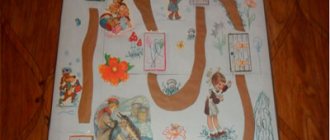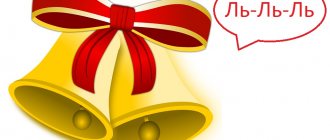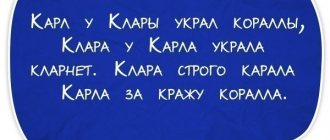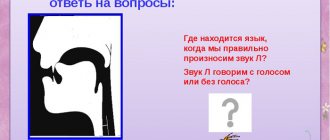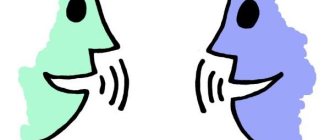Card index “Games for automation and differentiation of sounds”
The card index includes games that allow preschool children to practically master
preschool children during the game.
The purpose of the card index is to help speech therapists practically master the skills of automating and differentiating sounds in preschool children in games.
Sources
Shinkareva, L.N. Games for automating and differentiating sounds in preschool children
Levina E, V. Speech therapy games for automation and differentiation of sounds. Festival of pedagogical ideas “Open Lesson”.
Utenova T.V. DIY benefits. Festival of pedagogical ideas “Open Lesson”.
Let's help the elephant
Target:
automation of the “s” sound in words (the goal is the same in all games, so it will not be indicated further).
Material:
a plot picture depicting an elephant watering a flower bed with flowers from a watering can, measuring 30 x 20; 10-15 buckets, cut out of colored cardboard, with object pictures glued or drawn on the back of them, the name of which contains the sound “s” in a certain position or in different positions.
Progress of the game
We invite the child to look at the plot picture. We draw his attention to the fact that the elephant needs help. The flowerbed is large, there are many flowers, and it will take a lot of water to water it. Let the elephant water the flowers, I will help him. We will bring buckets of water. Next, we draw the child’s attention to the fact that there are pictures hidden in the buckets. If he names the picture correctly, he takes the bucket of water to the elephant, and if not, the bucket is put aside.
At the end of the lesson, a summary is made: did they bring much water to the elephant? Did we help him?
Who's on the plane?
Material:
plane plane made of cardboard with cut-out porthole windows and cut-out animal figures
Progress of the game
We invite the child to look at the animals (birds) and name them. We explain that animals would really like to fly on an airplane. The child takes a figurine of an animal, names it, clearly articulating the sound “s,” and places it in the window (as if the animal is looking out of a porthole). All animals are considered this way, and the child is invited to take them for a ride (run around the group) on the plane. Then the plane “landes”, the animals come out, and they are called again.
Sonya
goes on vacation
Material:
a large flat doll and small flat bags made of colored cardboard with object pictures on the back.
Progress of the game
We look at the doll, come up with a name for it, the name of which has the sound “s”. We pay attention to the large number of travel bags next to it. Let’s clarify: what are these bags for? Where can you go with these bags?
We invite the child to turn the bag over, see what is in it, and name the object.
At the end of the lesson, remember and name what items the Sonya doll took with her on vacation.
Let's take the sausages away from the mouse
Material:
a colorful plot picture depicting a mouse that has entered the kitchen, and sausages cut out of cardboard, on the back of which there are subject pictures.
Progress of the game
We look at the picture, name the objects and products available in the kitchen. We draw the child’s attention to the mouse, behind which is a string of sausages (we lay out the sausages behind the mouse in advance as if it were dragging them). The mouse stole the sausages, and we need to take them away from her.
The child is asked to turn the sausage over and name the object depicted on its back. If you name it correctly, the sausage will be taken away; if you make a mistake, the mouse will eat the sausage.
Let's treat the animals with juice
Material:
a plot picture depicting little animals or individual flat figures of animals and cups of juice cut out of cardboard, on the back of which are depicted vegetables and fruits.
Progress of the game
We look at the animals depicted. The child is invited to treat them with juice. To do this, you need to turn the glass over and correctly name the object depicted there. If the item is named incorrectly, the glass is removed and one of the animals is left without juice.
For older children this game can be made more difficult. They can be asked not only to name a vegetable or fruit, but also to form the corresponding adjectives. For example: plum - plum, apricot - apricot, cabbage - cabbage, etc.
Elephant circus performer
Material:
a picture depicting an elephant juggling colored balls - circles made of colored cardboard with subject pictures on the back.
Progress of the game
We invite the child to look at the magic circles that the elephant threw up and name what is drawn on their back side.
Who do we see in the windows?
Material:
a multi-storey cardboard house with cut out windows; cards made of blue cardboard the size of the windows with subject pictures on one side.
Progress of the game
Blue cards are inserted into the slotted windows. We explain to the child that all the residents in the house are still sleeping, which is why the windows are dark. Now morning has come, the residents wake up and each look out their window. The child is asked to open the windows one by one, that is, turn over the blue card and name who is drawn on it.
Let's put a bouquet in a vase
Material:
a large flat vase and small flowers of different or the same colors (made of cardboard), on the back of which there are images of various objects.
Progress of the game
The kid takes a flower, turns it over, correctly names the object, and only then puts it in a vase. The more correctly named words, the more magnificent the bouquet.
Let's help the bunny load his suitcases
I came across a plot picture depicting a bunny sitting on a carriage (a manual on speech development for 1st grade, 1999 edition). We cut out small suitcases from colored cardboard, drew in the necessary details, pasted object pictures on the back, and it became a game.
The child examines and names an object lying in a suitcase. He calls it correctly - the suitcase is loaded into the carriage. If the sound “z” in the title of the picture is pronounced distorted, the suitcase remains on the platform.
The game is more interesting if the suitcases are “loaded” into a slot cut in the door of the carriage.
Feed the bunny
Material:
a plot picture depicting a bunny gnawing on a carrot, and the required number of cardboard heads of cabbage or carrots (or both).
Progress of the game
Carrots are laid out on the table. The child names the pictures shown on the back of the carrots (heads of cabbage) and treats them to the bunny.
Let's collect beads
Material:
multi-colored cardboard circles with pictures on the back and thick thread.
Progress of the game
We tell the kid that the Zoya doll has a problem - the beads have scattered, and now we will collect them.
The child takes any circle, names the picture on its back and places the circle on a thread lying on the table. The more correct answers, the longer the beads.
Let's give the monkey some paint
The plot picture shows a monkey with a brush. The baby is invited to give her paints. To do this, he must correctly name the picture depicted on the back of the “paint” - a cardboard rectangle. The child names objects and places rectangles of paint near the monkey
Let's light stars in the sky
Material:
a sheet of dark blue cardboard and small stars made of yellow cardboard with subject pictures on the back.
Progress of the game
We clarify what time of day it is (during the game), and explain why. Let us remember what the sky is like during the day and at night? What shines in the sky at night? The child is invited to light stars in the sky. Magic stars - with pictures on the back. The kid names a picture whose name contains the sound “z” and places it on the “night sky” - a sheet of blue cardboard
Whose picture?
Material:
cards with pictures of family members (mother, father, grandmother, etc.) and smaller cards with pictures whose names contain the sound “z”.
Progress of the game
We invite the child to consider and name the objects depicted on the cards: watermelons, basins, roses, vase, umbrella, goat, castle, chisel, fence, blouse, birch, etc. Next, the child is asked to think about which family member needs which item and put it next to it a corresponding picture with it.
For example:
for mom - roses, an umbrella; for dad - a lock, a chisel; grandma - goats, etc.
Let's fill the squares with pictures
Material:
a pyramid of empty squares drawn on a sheet of cardboard; subject pictures on cards corresponding to the squares of the pyramid.
Progress of the game
We draw the child’s attention to the fact that the pyramid is not at all bright, its cells are empty, and we suggest placing pictures in them. The kid names the picture and places it in the empty square of the pyramid.
Let's collect buttons in
a handbag
Material:
a handbag sewn from cardboard using a needle stitch; “Buttons” are circles cut out of colored cardboard and painted accordingly.
Progress of the game
“Buttons” are laid out on the table. The child is asked to collect them in a bag. The button is put into the bag only after the picture on its back is correctly named.
Magic eggs
The plot picture shows a chicken standing near a nest full of eggs. Next to the picture are stacked “eggs” made of white cardboard with object pictures on the back side. We draw the child's attention to the fact that these eggs are magical, as they have pictures inside.
The baby takes the “egg”, names the picture and puts it in the nest. The same plot picture with the image of a chicken can be used for the game “The chicken hatched chickens.”
Let’s clarify who hatches from the mother hen’s eggs? What types of chickens are there? Take out flat figurines of chickens (one at a time). Moreover, the chick is “hatched” only if the picture on its back is correctly named
Let's collect cucumbers in a basket
A beautiful cardboard basket with a slot in the middle. Cucumbers made of the same colored cardboard with subject pictures on the back are laid out on the table.
The child is asked to collect cucumbers in a basket. He takes a cucumber, names the picture, clearly articulating the sound “ts,” and lowers it into the slot.
Gift to Santa Claus
Material:
mittens cut out of cardboard and beautifully painted with pictures on the back.
Progress of the game
A gift - a pair of mittens is sent to Santa Claus if the child correctly names the picture hidden inside the mitten.
Naughty kitten
Material:
circles made of colored cardboard, painted to look like balls.
Progress of the game
The balls are laid out on the table. We explain to the child that the kitten scattered grandma’s balls. To prevent grandma from being upset, they need to be collected.
We collect the balls either in a cardboard bag, which we used in the game “Gather Buttons in a Bag,” or in any beautiful box, or simply put them in a pile near the grandmother sleeping in the chair, shown in the plot picture.
Naturally, on the back of the glomeruli there are object pictures that the child must name correctly.
Let's treat the little mice
I came across a bright, attractive picture depicting sad, ruffled little mice. It can be used in one game.
We asked the children to explain why mice are so sad? The children assumed that they were hungry. Then they took out “pieces of cheese” cut out of cardboard and painted accordingly, with object pictures pasted on the back, the names of which had the sound “sh” in them, and they began to feed the little mice.
If the child names the picture, clearly articulating the sound “sh,” the mice receive a treat; if not, the “pieces of cheese” are put aside.
Chicken grains
It’s not at all difficult to find a colorful picture of a rooster . If you cut out grains from yellow cardboard (so that small object pictures fit on the back side), you will get this game. The chicken will get the grain only if the child correctly names the picture whose name contains the sound “sh”.
Belkin reserves
Material:
story picture depicting a squirrel sitting near a hollow; flat images of cones, mushrooms, nuts with accompanying pictures on the reverse side.
Progress of the game
We invite the child to remember where the squirrel sleeps? How does she prepare for winter? What supplies does he make for the winter? Where does the squirrel store its supplies?
We take out the hidden supplies “from the hollow” and lay them out on the table. Let's find out which words are hidden in the squirrels' reserves. The child must correctly name the words, in this case, those whose names contain a sound.
What
does a bear like?
Is the game similar to the previous one?
Let's clarify what the bear likes? We put on the table a row of barrels with object pictures drawn on the back. The child assumes that these barrels contain honey for the bear. We invite him to turn over the barrels and name the objects “hidden” in them.
The names of the pictures can contain any sounds that require their automation.
Piggy the artist
Material:
a plot picture depicting a pig with a palette and brushes in his hands in front of an empty easel; white cardboard rectangles (with frames) depicting objects whose names contain hissing sounds that we would like to train children in the pronunciation of.
Progress of the game
“Pictures” are displayed on an easel, the child names them, clearly articulating the desired sound.
Mushrooms for hedgehogs
Material:
a plot picture depicting a hedgehog carrying a basket; flat mushrooms with object pictures on the back side, the name of which contains the sound “zh”.
Progress of the game
The plot picture is considered. It is specified where the hedgehog is heading. (Children usually answer with confidence that they are going to the forest to pick mushrooms.)
It is proposed to help the hedgehog collect a full basket of mushrooms as quickly as possible. To do this, you need to correctly name the words hidden in the mushrooms. The child takes a mushroom, says the word and puts it in a basket.
(For greater interest, various mushrooms are cut out
-
chanterelles, boletus, etc.)
Hedgehogs
got lost
Material:
strips of cut green paper “grass” are glued onto a sheet of cardboard; flat figurines of hedgehogs with pictures, the names of which have an automated sound.
Progress of the game
Before the game, hedgehogs are hidden in “grass” (put into strips of paper).
It is explained to the child that the hedgehog has small babies (the child must name the babies himself), and they got lost in the grass. It is proposed to help the mother hedgehog. The child “finds” the hedgehog, correctly names the picture and returns it to his mother.
Who lives in the hut?
Material:
a beautifully painted hut made of cardboard with slits instead of windows; flat figures of animals, birds, insects (toad, giraffe, crane, beetle, etc.).
Progress of the game
A hut is being considered. Children are given the opportunity to guess why no one looks out the windows. Where have the residents gone?
Children are asked to close their eyes. The teacher quickly fills the windows with figures. The child opens his eyes, examines the residents, and names them.
Let's drink tea
Material:
a flat samovar or a picture with its image; beautifully painted flat cup; subject pictures pasted onto pieces of cardboard in the form of drops.
Progress of the game
We are looking at a picture of a samovar. Does it clarify what it is needed for? Then the “tea party” begins - droplet pictures drip from the samovar into the cup. The more correctly named pictures, the fuller the cup.
Let's help Cheburashka catch a butterfly
Material:
a picture of Cheburashka with a net; multi-colored butterflies with pictures on the back.
Progress of the game
Let's look at the picture. Let's clarify what Cheburashka is going to do? (Butterflies are laid out in advance on the table not far
It is proposed to help Cheburashka catch butterflies. The child chooses any butterfly, names the picture, and then it is caught. (At the end of the lesson, all butterflies are “released” to freedom.)
Decorate the Christmas tree with toys
Material:
Christmas tree cut out of velvet paper; small cardboard toys glued to velvet paper or flannel.
Progress of the game
The toys are named and attached to the Christmas tree.
Let's unload the car
Material:
a picture of a large truck; cardboard colored rectangles with subject pictures on one side.
Progress of the game
Cardboard rectangles are stacked on top of each other (in the form of boxes with cargo) in the back of the car.
The child is asked to unload the car with toys for kindergarten. The kid takes the “box,” names the toy in it, and puts it in a pile.
Let's put the fish in the aquarium
Material:
spacious aquarium made of cardboard; bright fish with pictures on the other side.
Progress of the game
We brought fish for the kindergarten. To prevent them from dying, they must be quickly released into the water. To do this, you need to clearly name the picture and place the “fish” in the aquarium.
Santa Claus brought gifts
Material:
Santa Claus cut out of cardboard; multi-colored cardboard bags.
Progress of the game
The child is asked to examine and name the items “lying” in the bags that Santa Claus prepared as gifts for the children.
Let's reap the harvest
Material:
a beautiful flat vase or bowl; flat images of vegetables or fruits (or both).
Progress of the game
Let us clarify when the harvest of vegetables (fruits) ripens? Where do they grow? We invite the child to choose vegetables (fruits), name them and place them in a vase.
Let's unhook the carriage
Material:
cardboard locomotive; trailers made of cardboard with subject pictures on one side.
Progress of the game
On the table, or better yet, on the floor, there is a steam locomotive and trailers behind it. The child is asked to look at and name what kind of cargo is in the cars. Then you can “unhook” the cars with the cargo that is needed for the kindergarten. The child selects the desired load and names it again
Let's eat dumplings
Material:
a large flat spoon (can be cut from a pack of real dumplings); dumplings made of cardboard with pictures.
Progress
of the game
We clarify whether the child knows what dumplings are and what they are made of?
We look at the dumplings made of cardboard and the pictures on their back. It is believed that one has eaten a “dumpling” if one names the picture correctly. Picture dumplings are placed on a spoon
Autumn leaves
Material:
cardboard tree trunk; multi-colored leaves made of cardboard with pictures on the back.
Progress of
the game
In front of the child on the table lies a tree with red, yellow, orange and other colored leaves.
Let us clarify, when do trees have leaves of these colors? (We clarify the signs of autumn.)
What happens to leaves in autumn? We offer a game: you named the picture on the back correctly - a leaf falls off the tree and falls to the ground.
Let's take away the fox's koloboks
Material:
yellow cardboard circles painted to look like koloboks; picture of a fox.
Progress of
the game
You can remember the fairy tale “Kolobok” (recall its content with several questions). Look at the “koloboks” lying on the table. Draw the child's attention to the fact that they are special because they contain pictures. A fox found these buns and wants to eat them. To prevent this from happening, you must name each picture correctly.
What's in Lusha's basket?
Material:
cardboard basket;
small flat objects whose names contain the sound “l”.
Progress of the game
The child pulls out pictures from the basket and names them, clearly articulating the sound “l”.
"Building houses"
Purpose of the game
: consolidate the correct pronunciation of sounds in words, develop phonemic awareness, fine motor skills.
Material:
subject pictures on rectangles or squares (bricks), and on a large triangle (roof).
Progress of the game:
build a house for some hero (using a sound that has been automated), for example: “R” - build a house for the Tiger, choosing only bricks whose picture names contain the sound “R”.
"Magic Flower"
Purpose of the game
: consolidate the correct pronunciation of sounds in words, develop phonemic perception, fine motor skills, visual memory.
Material:
subject pictures on colored petals and on the round core of the flower.
Progress of the game:
collect a flower by choosing petals for a given sound. After the child has collected a flower, the speech therapist asks the child to close his eyes and turns several petals face down. Having opened his eyes, the child must remember and name which pictures were on the inverted petals.
"The doll is dressing up"
Purpose of the game:
automation of set sounds in words, phrases, development of phonemic hearing, fine motor skills.
Material:
paper doll, object pictures pasted onto the silhouette of the dress.
Progress of the game:
Dresses are laid out in front of the child, the speech therapist invites the children to dress up the doll only in dresses that have a picture with a given sound.
"Present"
Purpose of the game
: consolidate the correct pronunciation of sounds in words, develop phonemic awareness, fine motor skills.
Material: Pictures depicting animals whose names contain a given sound (a multi-colored cord is attached to each picture). Object pictures with holes.
Progress of the game
: For example, “It’s Baby Elephant’s birthday. Let's give him gifts, but only those with the sound "S" in the name.
A child strings an object picture onto a string
"Give the doll some tea"
Purpose of the game:
automation of the delivered sound in words, phrases; development of phonemic awareness and fine motor skills.
Material:
subject pictures glued to cups made of colored cardboard (with a hole), a doll with an attached cord.
Progress of the game
: The speech therapist introduces the child to the Zhenya doll and says that Zhenya is very capricious - she likes to drink tea only from cups with pictures of her favorite sound “F”. Among the many cups, the speech therapist teacher asks you to find those with such pictures and string them on a cord.
"Gnomes"
Purpose of the game
: automation of delivered sound in words, phrases; development of fine motor skills, formation of nouns with suffixes of diminutive meaning.
Material:
Pictures depicting a large and a small gnome (a cord is attached to each); paired pictures depicting a large and a small object with a hole.
Progress of the game:
“Give large items to the big gnome, small ones to the little one.” The child strings objects on a string. For example, a big gnome has a mushroom, and a gnome has a mushroom.
"Gluttonous ball"
Purpose of the game:
automation of the delivered sound in words, phrases; development of phonemic awareness and fine motor skills.
Material:
A tennis ball with a cut in the middle (this is the mouth).
Progress of the game: “The ball loves to eat, but it only eats those pictures whose names contain a given sound.”
The child takes the ball in one hand and the pictures from the table with the other. After pressing on the ball, the child puts the pictures in its mouth.
Umbrellas for hedgehogs
Material:
a plot picture in which 2 hedgehogs are drawn holding umbrella handles (beating the top); made of colored cardboard for umbrella tops with pictures of differentiated sounds.
Progress of the game
The child is asked to: select umbrellas with one sound for one hedgehog, and umbrellas for the other with another sound (the umbrellas are laid out mixed up on the table).
Let's make peace between the little foxes
Material:
a picture of fox cubs fighting over a picture; object pictures with differentiated sounds.
Progress of the game
Look at the picture. Notice that the foxes are fighting over the picture. Invite the child to reconcile the fox cubs. To do this, you need to give pictures to everyone. The pictures are distributed among the fox cubs (one with sound..., the other with sound...).
If the child is still small, the pictures can be taken in two colors.
Football players
Material:
cardboard cutouts of football players wearing uniforms of different colors, with pictures on the back.
Progress of the game
The child is asked to divide the players into two teams. Players with pictures with one sound in their names are selected for one team, and players with a different sound for the other team.
For younger children, you can use not figurines of football players with pictures, but figurines of animals whose names contain differentiable sounds.
For example:
1st team - elephant, dog, fox..., 2nd team - frog, mouse...
Gifts for animals
From the cover of a drawing book, cut out a picture depicting a bunny and a squirrel gnawing cabbage and nuts. Let's color them. We paste pictures whose names contain sounds that the children mix together. And all that remains is to offer the game to the child.
You can find an innumerable variety of subject and subject pictures and use them to automate and differentiate sounds. You just need to always take into account the accessibility of the material for children, both semantic and syllabic
Mouse Peak
Goals:
● Develop phonemic perception - differentiation of sounds w - s using the material of words.
● Develop visual memory and attention.
● To develop the ability to coordinate numerals and nouns.
The manual is a cut-out image of a mouse and silhouettes of balloons depicting various objects whose names contain the sounds sh, s. The balloons are attached to the mouse using magnets. The child takes the ball, names the picture depicted on it, determines the presence of the sound w in the word and independently either attaches the ball or puts it aside.
